
Values Collage
Apparently I am meant to live by my values, if only I knew what they were.
What’s a value word? It’s hard to think up on the spot.
There are lists of suggested values on the internet. Staid concepts like honesty and harmony. Values most of us share but would struggle to rank if pressed to prioritise a top 5.
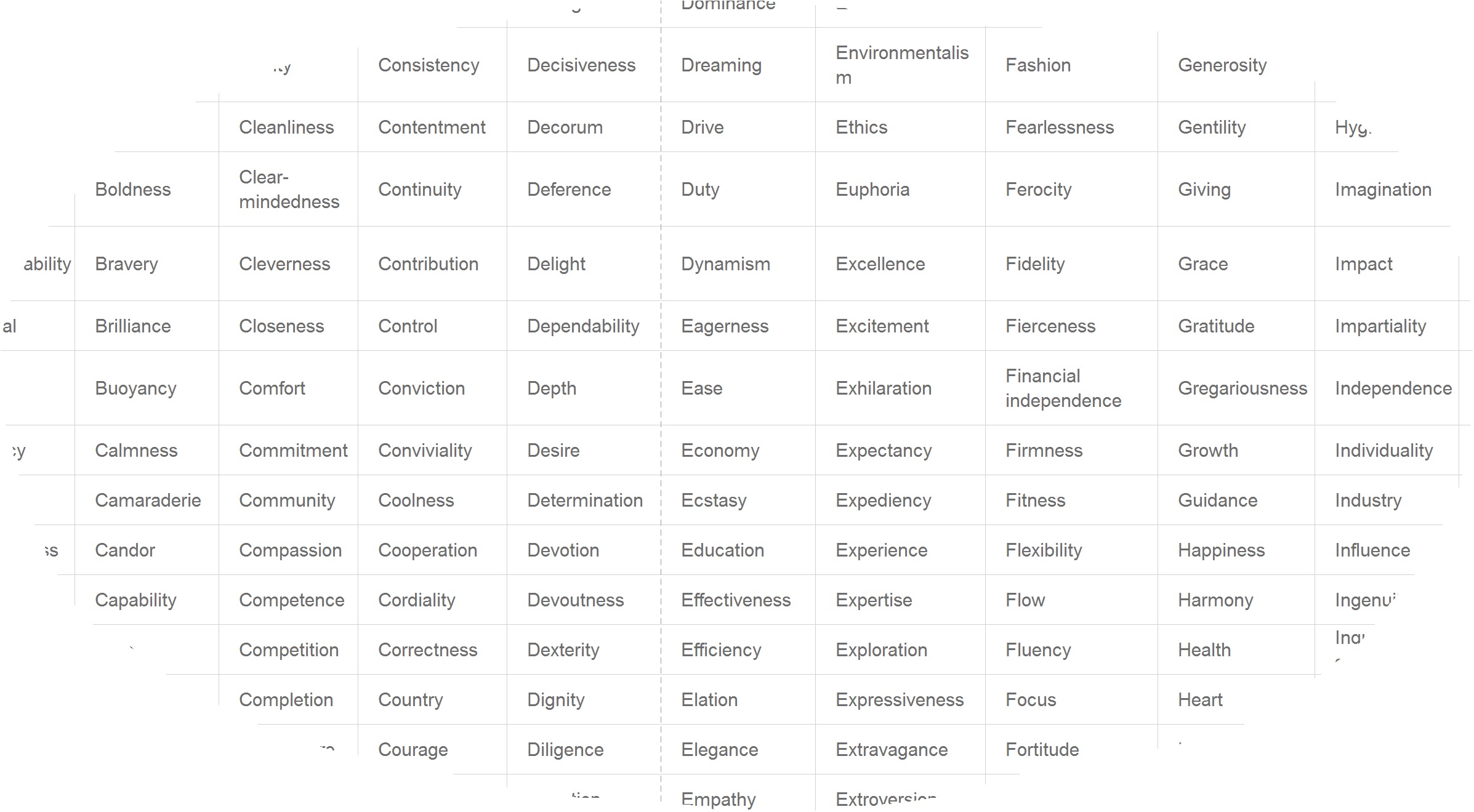
The list is a starting point, but what is missing? A while ago I met a corporate escapee turned jazz singer. She radiantly told me about now living her values, beauty and romance, which aren’t always in the ‘serious’ lists.
It’s tempting to pick the values you ‘should’ have rather than listening to the ones which you really connect to.
Instead of being limited by the list, or struggling to come up with words off the top of my head, I decided to let my intuition guide me by creating a collage.
The benefit of collage as medium is that I don’t have to create the artwork myself. I can flick through magazines and wait until I find something that ‘resonates’. I can choose phrases or pictures that say so much more about my complex values than simple words on a list.
ARTLAB
AIM
Discover my true values
MATERIALS
A variety of scrap magazines.
Scissors, glue and a piece of large paper.
METHOD
Set the intention to look for what resonates with your values.
Browse the magazines and notice your reaction.
If an image or piece of text resonates, check in with yourself – does this feel like a should or a true value?
Cut true value pieces and set aside (Optional: keep ‘should’ values for an alternative collage on the values that have been imposed on you)
Arrange cutouts on piece of paper and glue in place
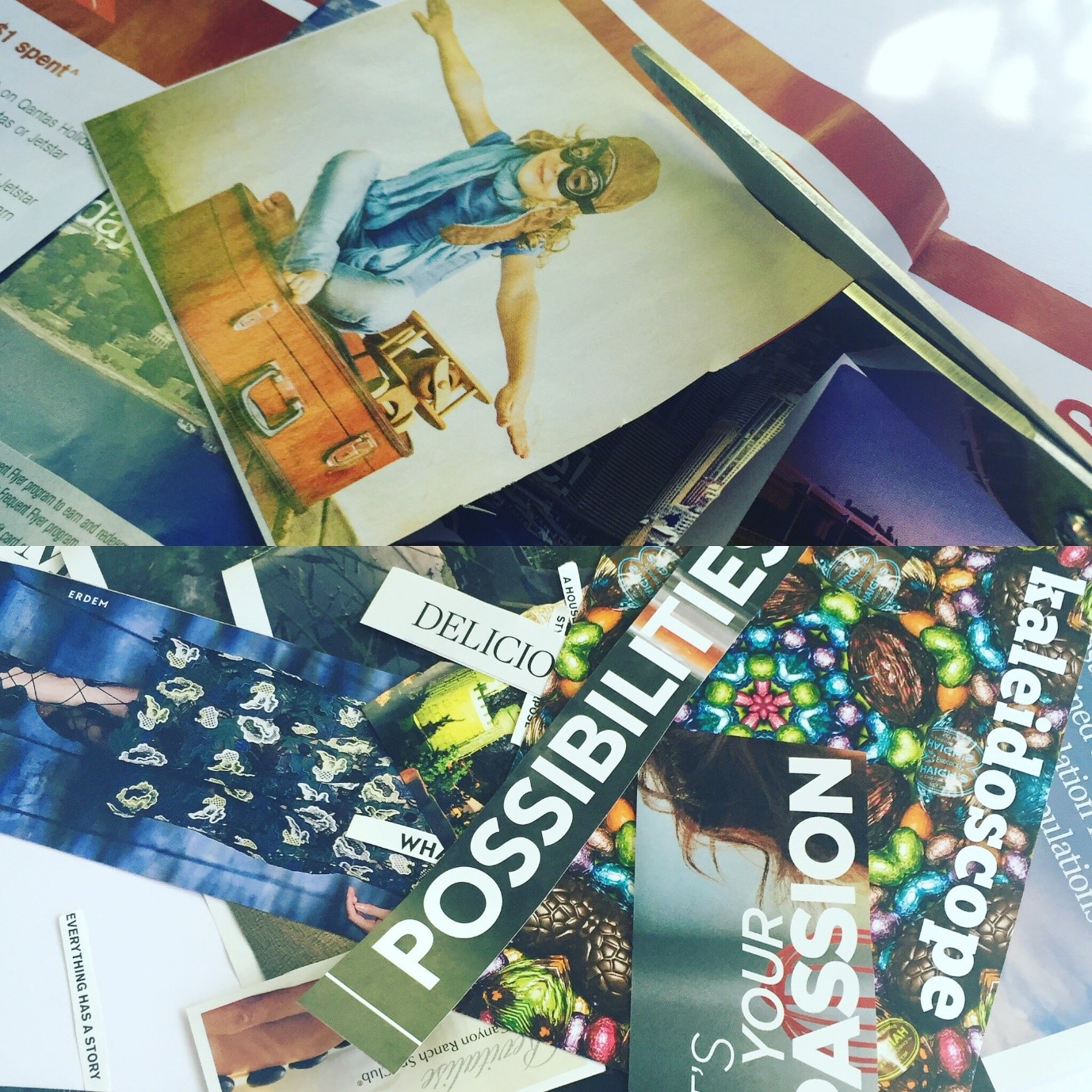
RESULTS
I stuck my values up on my whiteboard as a reminder.
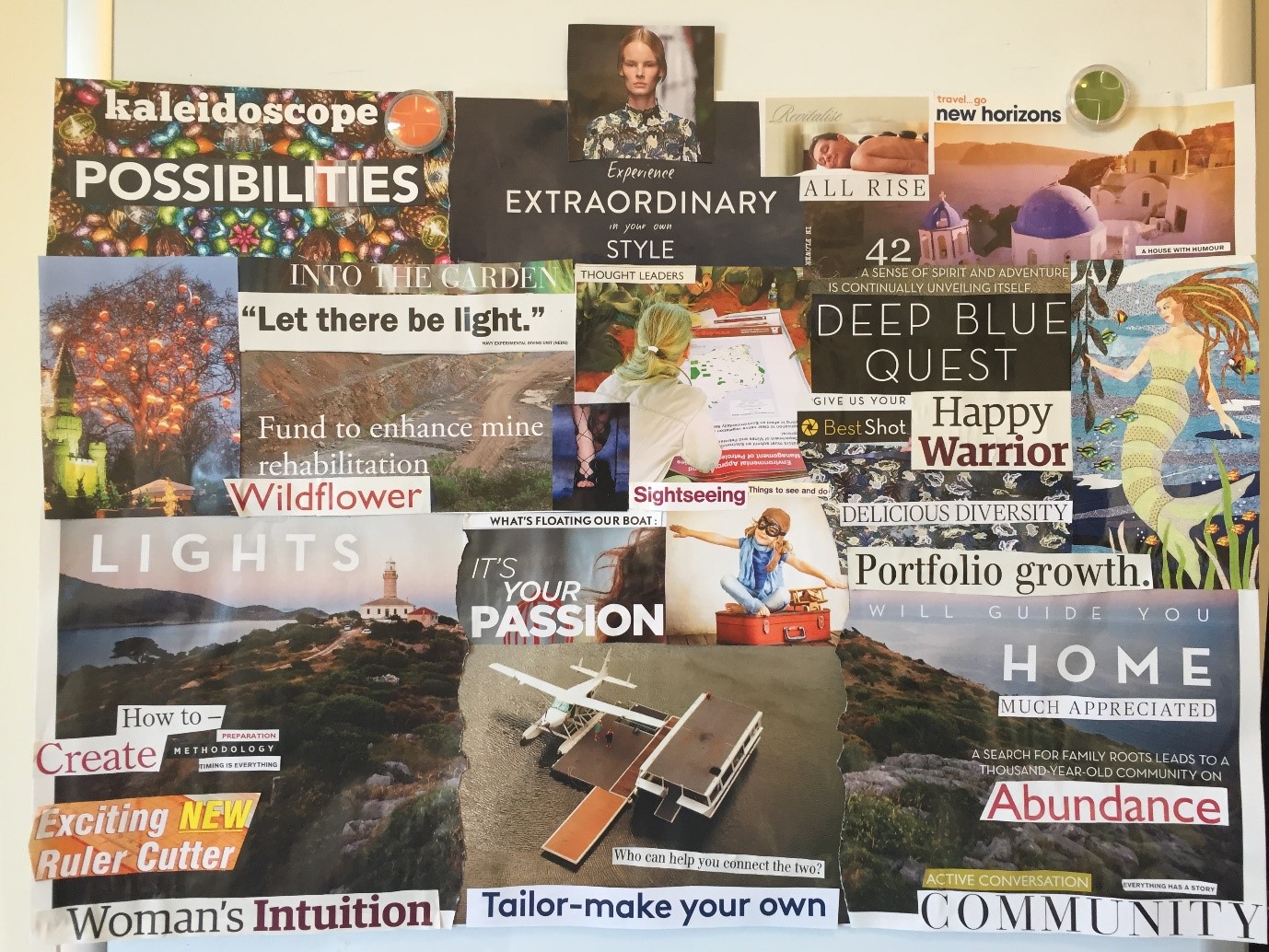
DISCUSSION
I wasn’t sure why I chose some pieces but it became clear by the end. I had to trust the process, that I had chosen enough, but that I had space and it would all fall into place.
I noticed the underside (option: choose images and stick upside down for interesting reveal).
What did I leave out – ‘expert how-to’. What did I rearrange – a model, using the feet, head and patterns separately.
Once finished I noticed themes emerge; light to the deep home, the quest and adventure for new experiences, nature describing growth. I also arranged the collage in a timeline; past, present future. I was heading home to the future. A head above, the watcher.
It didn’t make sense to me to reduce this rich picture to a list of 5 top value words. Instead I have this to refer to, asking myself “does this action fit within this picture?”
This activity is something I can redo to see if my values shift over time.
CONCLUSION
I am quite happy with this picture as a collection of my values. It has more depth than a list of value words, it’s more personal. I can still use this to evaluate my decisions.
It has been a few months now since I created the collage and I’ve noticed that I’ve turned some of the images into reality. The travel theme is strong, I recently returned from a European holiday including visiting Santorini – the picture in the top right corner. I didn’t consciously use the values collage to book my trip but it was stuck on my wall, I wonder if that influenced me?
Try this for yourself and share your insights here.
Try this for yourself and share your insights.
Reflect
- Do you have a list of top values, do they reflect you well?
- Do your values come from a place of ‘should’ or authenticity?
- How does it feel when you are aligned with your values?
- Do you bring your values into everyday decisions?
- Can you display your values as part of your branding/identity (personal or business)? Are you known for your values?
30 Day Challenge: Paint Your Feelings
Occasionally when I tell people about art therapy I get a sceptical response, “You mean you paint your feelings?”.
The answer is, well, yes. After all, don’t we write about our feelings, talk about our feelings, even sing about our feelings (or at least listen to others who do).
Expressing our feelings through art may not be what you’re used to but it’s not a new technique. Before humans had words to express the complex emotions we experience, we had the tools of art to draw, move our bodies and sound out what we felt inside.
We express to understand ourselves, and share to understand each other.
I will be starting a 30 day art journal where I will paint my feelings and share it with you on instagram. You are welcome to join in and post your daily artworks #paintyourfeelings30.
I call this a challenge not because it’s hard in a technical sense. To pick up a paintbrush and swoosh the page with watercolours only requires I make the time for myself to do so. Showing up is most of the battle. In our busy routines, who has time for another ritual?
Who has time to feel?
The scary part of this activity is being alone and present to your feelings as they show up on the page. But this is also its value. Normally we do our best to push through despite our feelings, to numb them before they surface, this creates a safe space where they can breathe.
Emotions are just signals, messages telling us how we are experiencing life. We might not always enjoy what the feelings have to say, but by ignoring them we lose touch with ourselves, or risk them becoming louder and louder until they erupt inconveniently.
Taking the time to tune in to how we feel by doing a quick painting is care and maintenance for emotional awareness. Awareness of our own emotional state is the first step in developing emotional intelligence. By following the pictures over time we may find patterns and insights into how we are progressing. Sharing the pictures on social media is a way to connect with others by showing how you are feeling, without having to find the words or disclose sensitive details.
I have done many art journals before and while at the time not all of the pictures made sense, it was a good clearinghouse for the emotions of the day. I usually painted at night, reflecting on the day and clearing my mind before sleep, but whenever works for you is the best for you.
Again I welcome you to join in, whether you choose to share via social media or not. I’d like to hear about how you find the challenge.
ARTLAB
AIM
Acknowledge and release feelings.
MATERIALS
A plain notebook or sheets of paper that can be collected in order.
I like watercolours for expressing emotion because of their fluid nature, liquid watercolours are especially intense. You may prefer chalk or oil pastels, depending on what resonates with your feelings.
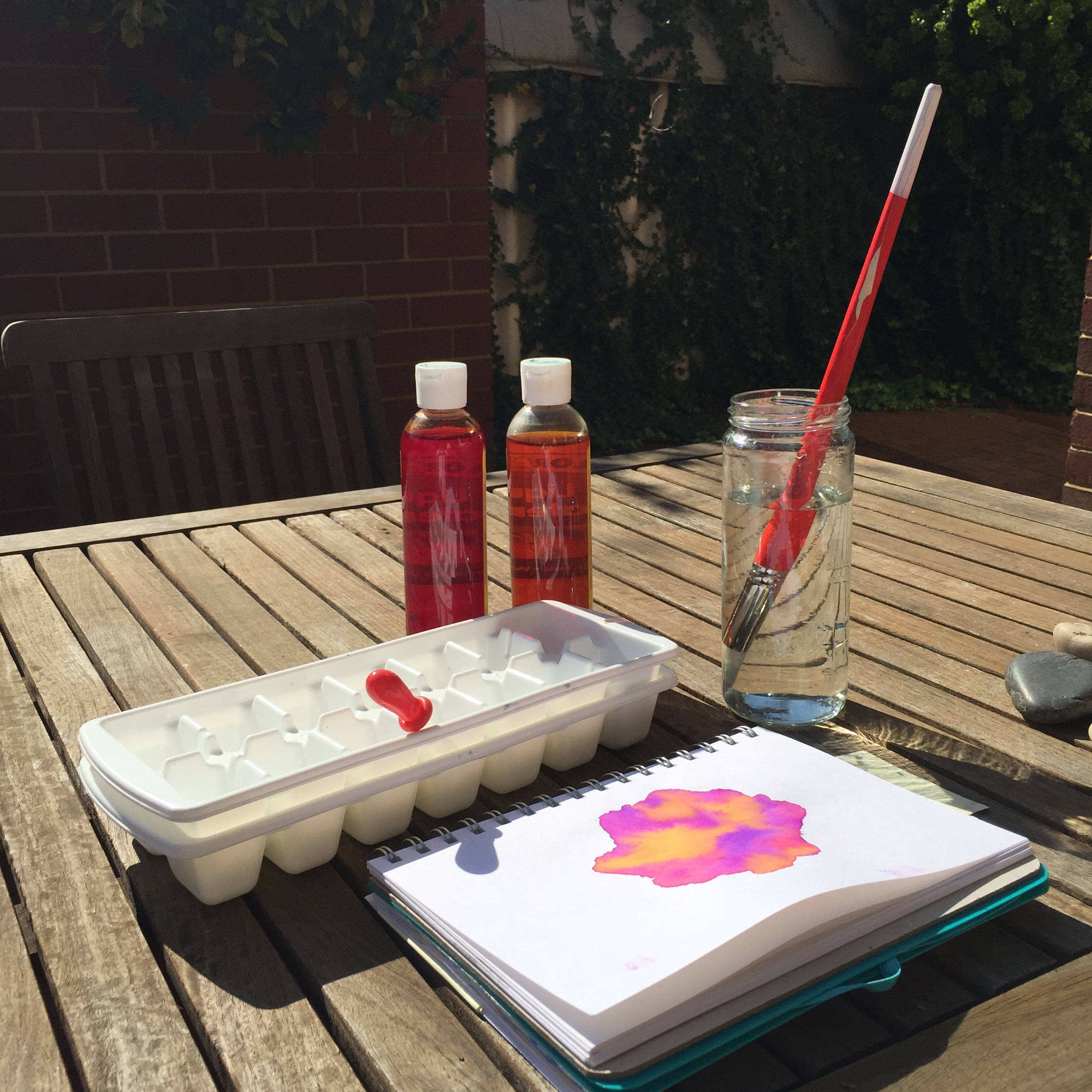
METHOD
If possible, pick a regular time of day to make this activity a routine part of the next 30 days.
Take a moment to remove distractions and focus on how you have felt for the past day.
Create a picture that expresses those feelings. Use colours, lines and shapes that connect with your emotions. Abstract pictures are encouraged here, but if you want to include pictorial elements that is OK.
I am adding a creative constraint, first choosing only 3 colours to use and adding an optional fourth colour at the end.
Number and date your artwork. Title optional.
RESULTS
Post your daily pictures to instagram, sharing with the tag #paintyourfeelings30.
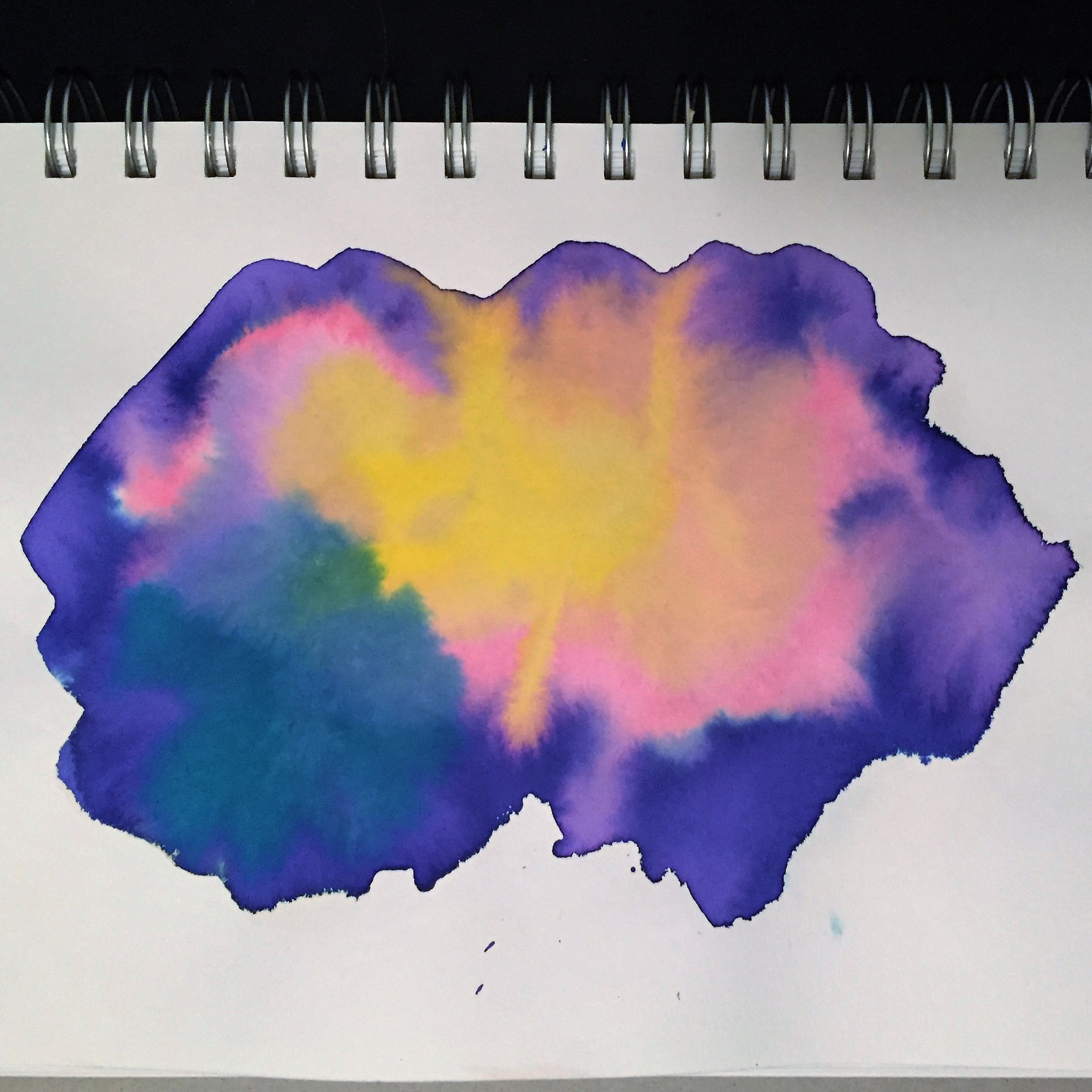
DISCUSSION
Notice who else on instagram is painting their emotions.
Check in during the challenge for more suggestions for reflection.
Who and What is Art Therapy For?
Don’t let the finger painting and crayons fool you. Art therapy is not just for kids, though it may inspire your own inner child aspects. Art therapy is suitable for all ages, abilities and experience. I work primarily with adults and adolescents (particularly teenage girls).
The art therapy process can be adapted to a range of issues but my focus is on mood disorders and emotional intelligence, interpersonal challenges, goals and direction, mindfulness and stress management, eating disorders.
My (current) favourite art materials for creative self-expression

In my own reflective art practice I experiment with materials that I find, noting their qualities and thinking cool new ways to use them. These are a few of my recent favourites.
Found Objects
AKA junk.
Making art doesn’t need to be expensive. Indulging in luxurious materials has it’s place, but what about the creative challenge of using what you have? I love the metaphor or using what was discarded, waste, rejected, and turning into a unique, beautiful or meaningful object.
You can rely on serendipity to bring you what you need, when you need it. Or up-cycling centres (like Remida’s Creative Reuse Centre) are a sustainable source for environmentally conscious projects.
I’ve made wings with feathers found along the river, I’ve put jewels in clay crowns by firing pieces of broken glass collected from a park, I’ve glued discarded safety glasses into a hat decoration.

Clay
The sensory intensity of clay makes it a risky choice for first use, but once you are comfortable with how it feels it is a flexible way to sculpture. Dried clay can be fired to make it permanent but I enjoy the fluid nature of working with wet clay. It seems to take shape in my hands through play, evolving even without thinking of the final form. Clay can also tolerate a lot of force, squishing a ‘baddie’ made of clay is a satisfying safe outlet for destruction.

Art Therapy Materials for Creative Self-Expression

This is the fun part.
When I was little, I used to visit my Dad at his office and marvel over the array of pens and other stationery. It was my dream to grow up and work in a place with a magnificent stationery collection.
The great part of being an art therapist is the excuse to collect all sorts of artsy-crafty materials and PLAY with them!
If you spend your day typing documents or entering data into spreadsheets (as I used to) you can feel detached from the childlike fun of creative expression. Even if this part of you has been long forgotten, it’s still there! Art therapy is a great way to reawaken this innate urge for creative play.
As an adult, we are used to expressing ourselves like adults. Sounding ‘professional’. Being ‘serious’. Using big words (guilty). This leads to a dry lack of connection. We can intellectualise and filter our words and hide the emotional content from others and ourselves.
Why Use Art for Creative Self-expression?
Art materials are engaging in a sensory and emotional way. When you want to get out how you feel, or really describe your experiences you can talk about it or write about it (and I recommend this, 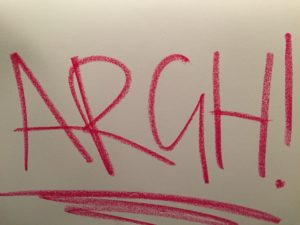 especially writing). But imagine the release you feel scrawling a red crayon across a large sheet of paper in big, zig-zag lines, a safe outlet for frustration “GRRRR”.
especially writing). But imagine the release you feel scrawling a red crayon across a large sheet of paper in big, zig-zag lines, a safe outlet for frustration “GRRRR”.
Engaging sensory and emotional experiences produce lasting change.
If you’ve ever read a self-help book and thought ‘fascinating, I understand’ like a detached observer of your own life, and then nothing changes then you are aware of needing to work through the feeling part for lasting effect. Sensory and emotional experience reinforces learning. The more immersive an experience you can learn from, the more it will stick. This is why it’s hard to remember the pages of procedure steps that you read, but if taught using a crisis scenario or corrected mistakes you’ll be sure to get it right the next time.
Art materials are so powerful that often it’s better to start gently, to reduce the risk of emotional overwhelm. You might not be ready to ‘see’ a picture of a traumatic experience and there is no need to revisit it. But when you’re ready to reinforce insights, or practice solutions, using engaging modalities like role play help prepare you for using new skills in real life. 
There’s no limit to the types of art materials that can be used in art therapy. Conventionally there are paints, pencils, crayons. But what about glitter, felt, popsticks, pipecleaners, rocks, masks, role play, movement, sound?
In my travelling toolkit I bring as much as I can fit so I have as much choice as possible when working with a client. I also check for allergies and if you have a particular aversion to a material that is ok, we can find one that you can work with.
My favourite art materials
Art Therapy Process: What to expect in session
How does the art therapy process work in session?
If you’ve never had a session with an art therapist before, you may be curious about the unknown, how exactly does it work? If you have worked with an art therapist before, I want to share my process with you so you know what to expect from me.
Generally when choosing to attend an art therapy session you’ll have some outcome you are hoping to achieve, an improvement on your current situation. As a therapist I help you clarify the goal you are working towards so I can make sure we are heading in the right direction. Examples goals could be emotional (from depression and anxiety to feeling happy, calm and content about life) or decisions (from confusion and overwhelm to understanding the options available and being confident in choices made), but no one person is the same and the process is tailored to what you want. If you’d like to discuss whether art therapy is the right match for your goals, please book a introductory call.
As an art therapist, I then act as a facilitator by suggesting materials and activities to help work through from where you are to where you want to be. We might start by having a closer look at where you are right now, using art materials that resonate with how you are feeling to release and acknowledge your experience.
You might draw a picture of your current situation, or paint, or make a sculpture. No artistic experience is necessary and there is no wrong answer. This is not like the kind of art classes you might have taken in school, where you were told what to draw, what colours to use and marked on staying between the lines. This is about having the freedom to express yourself, however that may look. I’ll support you so you feel comfortable.
The process of creating art is powerful in itself, but it is also possible to reflect consciously on what you have created. I might ask you questions about your artwork to help you find your own insights about what you see in it. However it is not my role to tell you what your artwork means, I do not interpret art or pass judgement. Only you can know what your artwork means to you. I am here to help you discover it for yourself.
As you explore your artwork you may pick up clues which lead towards your goal state. Perhaps you will find a new perspective, another way of looking at things which changes how you feel. Or an idea how you can change the picture, or change the story. I can help you make these changes by giving you the tools to modify the artwork or create new ones. You might add in resources, or remove the blocks that are holding you back. The artwork is a creative space to play with these solutions, a model for how these changes might play out in your own life.
At the end of the creative process your artwork is yours to keep. It is you choice in what you do with it. Maybe you’ll display it at home as a reminder of the insights achieved in the session. Or you might destroy it, as a symbolic gesture of letting go of what no longer serves a purpose.
Finally, I’ll check in with you and get your feedback on the session and the direction that you would like to continue with.
This is an overview of the art therapy process which can be hard to describe, every person is different and the easiest way to learn about it is to experience it.
In my ARTLABs I share my own process, using real life examples of how it has worked for me.
Art Therapy: Explained to an Engineer

Melbourne Cup Hard Hat
At first glance, there is no obvious connection between engineering and art therapy. Engineering is about maths and technical machines, art therapy is about feelings and expression.
Why would a chemical engineer want to become an art therapist?
The following is a ‘woo woo’ free explanation of the art therapy process in terms an engineer can relate to.
Engineering and art therapy have a lot in common. They concern transformation, relationships, sequences of events. They solve complex problems. They use symbols and diagrams to explain and design new realities.
In my past work as a chemical engineer the objective was to turn base minerals into a valuable product. In the same way, art therapy is a technique for taking the grit that life gives you and transforming it into something meaningful.
Consider the role of drawings in engineering. Depending on the type of engineer you are, you know how to read Piping and Instrumentation Diagrams (P&IDs), Process Flow Diagrams (PFDs), Single Line Diagrams (SLDs).
What looks like a mass of lines, shapes and symbols to the layperson becomes a meaningful map of reality for an engineer.
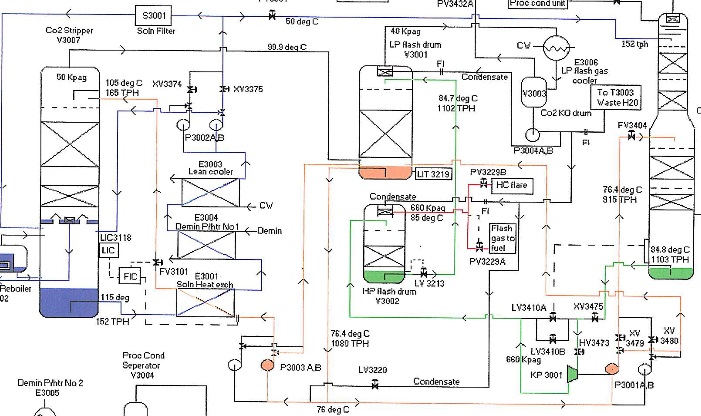
Complex relationships expressed using lines, symbols and colours
Imagine that you’re working on a complex problem.
First, you need to understand the system. You’re dealing with a confusing mess of pipes, buildings, cables and of course, no drawings. So, you create one. You walk the line, take notes and construct a diagram that represents the complex system on the page.
If you’ve constructed a diagram like this then you know that while it’s hard work, it’s satisfying to finally unburden the tangle in your mind to a clear picture. This is like the expression stage of art therapy. Getting the complex system out of your head and onto the page.
Once you’ve got your engineering drawing you can start to look at it, find insights that you weren’t aware of. That line goes nowhere. This line is blocked, but this other line is an alternative path.
In engineering drawings you have a legend, a key which tells you which colour means what, what the symbols refer to. In art therapy colours, lines, shapes and symbols are used too but this time it is you that decides what it means. Your red might mean strong emotions, a line describes the connection in a relationship, the order is a story that is told from left to right, and even an animal might represent a person you know. By looking at your artwork in art therapy, you can begin to understand yourself and your situation better.
What if your drawing is wrong?
Changing an engineering drawing can be time consuming. Red-lined markups showing how it should, or will be. Submitting changes for approval, updating the system. In art therapy you have control over your artwork. You get a chance to think creatively how you can change the situation, move things around, get rid of something, add something in. Sometimes the answer is to scrunch up the piece of paper and start again.
You are the designer, you can recreate the map.

What is the colour red telling you?
These three steps in art therapy – expression, understanding, healing – map onto the problem solving stages in design.
Design is not the end of the project. Implementation is required to take the insights and solutions that were discovered during the process and make them reality. Art therapy can give a new perspective on a situation, and help you figure out how to resolve it but it’s up to you to take action and make the real changes in your life.
Need an action plan? Wait till you see the art therapy version of a Gantt chart.
Pen Licence
I am not allowed to write this.
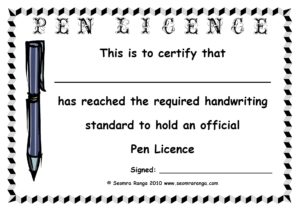 I didn’t get my pen licence in primary school. I grew up in Australia where this was a thing. Most kids in my school were awarded pen licences in Year 3. Each week we applauded a new batch of graduates as they received their certificates in front of the class.
I didn’t get my pen licence in primary school. I grew up in Australia where this was a thing. Most kids in my school were awarded pen licences in Year 3. Each week we applauded a new batch of graduates as they received their certificates in front of the class.
Permission to use pen was a big deal. Using pen was grown up. Pen was for getting it right first time. Pencil was for making mistakes, erasing evidence of where you had been wrong, and trying again. Pencil was for when you didn’t know what you were doing.
Having a pen licence meant you were perfect. The other kids with their correctly spelled words in neat, flowing cursive. My writing was a scrappy mess. I was left behind in a group with two boys, one who put capital letters in the middle of his last name. Was I that bad?
Wasn’t I good enough to get my pen licence?
The next year I had a new teacher. All the kids were using pens and I wasn’t sure what to do. I still hadn’t been told I could start using a pen. I felt sneaky picking up a biro to join in, like I was going to get caught and publicly exposed as an impostor.
This feeling that I hadn’t earned the right to write stayed with me. It stayed with me when teachers told me I would fail exams because of my scrawled handwriting. It surfaced in high school when I had to decide which English class to take, choosing the easiest one because “writing isn’t my thing”. And I was reminded each time I had to write an essay after leaving engineering. I was an engineer, engineers can’t write! Not being able to write had become part of my identity.
I couldn’t avoid writing forever. When I had to do it, writing was hard. The thoughts in my head didn’t materialise perfectly onto the page. I saw this as more evidence of my failure.
But what if I could use pencil? I could write a draft, no pressure. Let the ideas out in rough form without judgment. Experiment, rework, polish.
What if I could write with whatever I wanted? Stop saving the special pens for special occasions. Stop waiting to be told I when I was ready to use them.
I wasn’t 8 years old anymore, it was time to give myself permission to write.
ARTLAB
AIM
To give myself permission to write
MATERIALS
A fancy pen I used a calligraphy pen (I was gifted but hadn’t used because my calligraphy skills ‘weren’t good enough’)
Fancy paper or card for the certificate (I used 2 pieces of card to create a frame effect)
Stamps and stickers (I used gold stars like the ones awarded in primary school)
METHOD
Cut cardboard to form the certificate
Draft certificate wording on scrap piece of paper (optional)
Layout and write licence
Decorate with gold star stickers
RESULTS

DISCUSSION
It was hard not to judge myself. I created a certificate saying I could write, shouldn’t that be neat and spelled correctly? But that was the point.
I gave myself permission to write, even if it wasn’t perfect.
I used pencil grid lines but I didn’t really stick to them and that’s OK. There are no penalties for going outside the lines here. And while my calligraphy was hasty and unpracticed, it gets the message across. I can improve my style over time if I let myself use the pen more often. The certificate sits above my computer as a reminder to write every time I feel awkward.
CONCLUSION
The certificate isn’t going to turn me into a competent and confident writer overnight. Having the reminder in my workspace should push me to keep writing even when it’s hard. By continuing to write, over time I should grow more comfortable. A writer is someone who writes.
Try this for yourself and share your insights.
Reflect
1. Where in your life have you been waiting for permission from someone else?
2. What would you do if you had permission?
3. Do you have any ‘special’ art materials (like fancy pens, papers) that you have put aside until you’re ‘good enough’ to use them?
4. What message would you need to receive to feel that you are allowed?
5. Could you display a reminder that you have permission, even if it isn’t perfect?
Values Collage
Apparently I am meant to live by my values, if only I knew what they were.
What’s a value word? It’s hard to think up on the spot.
There are lists of suggested values on the internet. Staid concepts like honesty and harmony. Values most of us share but would struggle to rank if pressed to prioritise a top 5.

The list is a starting point, but what is missing? A while ago I met a corporate escapee turned jazz singer. She radiantly told me about now living her values, beauty and romance, which aren’t always in the ‘serious’ lists.
It’s tempting to pick the values you ‘should’ have rather than listening to the ones which you really connect to.
Instead of being limited by the list, or struggling to come up with words off the top of my head, I decided to let my intuition guide me by creating a collage.
The benefit of collage as medium is that I don’t have to create the artwork myself. I can flick through magazines and wait until I find something that ‘resonates’. I can choose phrases or pictures that say so much more about my complex values than simple words on a list.
ARTLAB
AIM
Discover my true values
MATERIALS
A variety of scrap magazines.
Scissors, glue and a piece of large paper.
METHOD
Set the intention to look for what resonates with your values.
Browse the magazines and notice your reaction.
If an image or piece of text resonates, check in with yourself – does this feel like a should or a true value?
Cut true value pieces and set aside (Optional: keep ‘should’ values for an alternative collage on the values that have been imposed on you)
Arrange cutouts on piece of paper and glue in place

RESULTS
I stuck my values up on my whiteboard as a reminder.

DISCUSSION
I wasn’t sure why I chose some pieces but it became clear by the end. I had to trust the process, that I had chosen enough, but that I had space and it would all fall into place.
I noticed the underside (option: choose images and stick upside down for interesting reveal).
What did I leave out – ‘expert how-to’. What did I rearrange – a model, using the feet, head and patterns separately.
Once finished I noticed themes emerge; light to the deep home, the quest and adventure for new experiences, nature describing growth. I also arranged the collage in a timeline; past, present future. I was heading home to the future. A head above, the watcher.
It didn’t make sense to me to reduce this rich picture to a list of 5 top value words. Instead I have this to refer to, asking myself “does this action fit within this picture?”
This activity is something I can redo to see if my values shift over time.
CONCLUSION
I am quite happy with this picture as a collection of my values. It has more depth than a list of value words, it’s more personal. I can still use this to evaluate my decisions.
It has been a few months now since I created the collage and I’ve noticed that I’ve turned some of the images into reality. The travel theme is strong, I recently returned from a European holiday including visiting Santorini – the picture in the top right corner. I didn’t consciously use the values collage to book my trip but it was stuck on my wall, I wonder if that influenced me?
Try this for yourself and share your insights here.
Try this for yourself and share your insights.
Reflect
- Do you have a list of top values, do they reflect you well?
- Do your values come from a place of ‘should’ or authenticity?
- How does it feel when you are aligned with your values?
- Do you bring your values into everyday decisions?
- Can you display your values as part of your branding/identity (personal or business)? Are you known for your values?
30 Day Challenge: Paint Your Feelings
Occasionally when I tell people about art therapy I get a sceptical response, “You mean you paint your feelings?”.
The answer is, well, yes. After all, don’t we write about our feelings, talk about our feelings, even sing about our feelings (or at least listen to others who do).
Expressing our feelings through art may not be what you’re used to but it’s not a new technique. Before humans had words to express the complex emotions we experience, we had the tools of art to draw, move our bodies and sound out what we felt inside.
We express to understand ourselves, and share to understand each other.
I will be starting a 30 day art journal where I will paint my feelings and share it with you on instagram. You are welcome to join in and post your daily artworks #paintyourfeelings30.
I call this a challenge not because it’s hard in a technical sense. To pick up a paintbrush and swoosh the page with watercolours only requires I make the time for myself to do so. Showing up is most of the battle. In our busy routines, who has time for another ritual?
Who has time to feel?
The scary part of this activity is being alone and present to your feelings as they show up on the page. But this is also its value. Normally we do our best to push through despite our feelings, to numb them before they surface, this creates a safe space where they can breathe.
Emotions are just signals, messages telling us how we are experiencing life. We might not always enjoy what the feelings have to say, but by ignoring them we lose touch with ourselves, or risk them becoming louder and louder until they erupt inconveniently.
Taking the time to tune in to how we feel by doing a quick painting is care and maintenance for emotional awareness. Awareness of our own emotional state is the first step in developing emotional intelligence. By following the pictures over time we may find patterns and insights into how we are progressing. Sharing the pictures on social media is a way to connect with others by showing how you are feeling, without having to find the words or disclose sensitive details.
I have done many art journals before and while at the time not all of the pictures made sense, it was a good clearinghouse for the emotions of the day. I usually painted at night, reflecting on the day and clearing my mind before sleep, but whenever works for you is the best for you.
Again I welcome you to join in, whether you choose to share via social media or not. I’d like to hear about how you find the challenge.
ARTLAB
AIM
Acknowledge and release feelings.
MATERIALS
A plain notebook or sheets of paper that can be collected in order.
I like watercolours for expressing emotion because of their fluid nature, liquid watercolours are especially intense. You may prefer chalk or oil pastels, depending on what resonates with your feelings.

METHOD
If possible, pick a regular time of day to make this activity a routine part of the next 30 days.
Take a moment to remove distractions and focus on how you have felt for the past day.
Create a picture that expresses those feelings. Use colours, lines and shapes that connect with your emotions. Abstract pictures are encouraged here, but if you want to include pictorial elements that is OK.
I am adding a creative constraint, first choosing only 3 colours to use and adding an optional fourth colour at the end.
Number and date your artwork. Title optional.
RESULTS
Post your daily pictures to instagram, sharing with the tag #paintyourfeelings30.

DISCUSSION
Notice who else on instagram is painting their emotions.
Check in during the challenge for more suggestions for reflection.
Who and What is Art Therapy For?
Don’t let the finger painting and crayons fool you. Art therapy is not just for kids, though it may inspire your own inner child aspects. Art therapy is suitable for all ages, abilities and experience. I work primarily with adults and adolescents (particularly teenage girls).
The art therapy process can be adapted to a range of issues but my focus is on mood disorders and emotional intelligence, interpersonal challenges, goals and direction, mindfulness and stress management, eating disorders.
My (current) favourite art materials for creative self-expression

In my own reflective art practice I experiment with materials that I find, noting their qualities and thinking cool new ways to use them. These are a few of my recent favourites.
Found Objects
AKA junk.
Making art doesn’t need to be expensive. Indulging in luxurious materials has it’s place, but what about the creative challenge of using what you have? I love the metaphor or using what was discarded, waste, rejected, and turning into a unique, beautiful or meaningful object.
You can rely on serendipity to bring you what you need, when you need it. Or up-cycling centres (like Remida’s Creative Reuse Centre) are a sustainable source for environmentally conscious projects.
I’ve made wings with feathers found along the river, I’ve put jewels in clay crowns by firing pieces of broken glass collected from a park, I’ve glued discarded safety glasses into a hat decoration.

Clay
The sensory intensity of clay makes it a risky choice for first use, but once you are comfortable with how it feels it is a flexible way to sculpture. Dried clay can be fired to make it permanent but I enjoy the fluid nature of working with wet clay. It seems to take shape in my hands through play, evolving even without thinking of the final form. Clay can also tolerate a lot of force, squishing a ‘baddie’ made of clay is a satisfying safe outlet for destruction.

Art Therapy Materials for Creative Self-Expression

This is the fun part.
When I was little, I used to visit my Dad at his office and marvel over the array of pens and other stationery. It was my dream to grow up and work in a place with a magnificent stationery collection.
The great part of being an art therapist is the excuse to collect all sorts of artsy-crafty materials and PLAY with them!
If you spend your day typing documents or entering data into spreadsheets (as I used to) you can feel detached from the childlike fun of creative expression. Even if this part of you has been long forgotten, it’s still there! Art therapy is a great way to reawaken this innate urge for creative play.
As an adult, we are used to expressing ourselves like adults. Sounding ‘professional’. Being ‘serious’. Using big words (guilty). This leads to a dry lack of connection. We can intellectualise and filter our words and hide the emotional content from others and ourselves.
Why Use Art for Creative Self-expression?
Art materials are engaging in a sensory and emotional way. When you want to get out how you feel, or really describe your experiences you can talk about it or write about it (and I recommend this,  especially writing). But imagine the release you feel scrawling a red crayon across a large sheet of paper in big, zig-zag lines, a safe outlet for frustration “GRRRR”.
especially writing). But imagine the release you feel scrawling a red crayon across a large sheet of paper in big, zig-zag lines, a safe outlet for frustration “GRRRR”.
Engaging sensory and emotional experiences produce lasting change.
If you’ve ever read a self-help book and thought ‘fascinating, I understand’ like a detached observer of your own life, and then nothing changes then you are aware of needing to work through the feeling part for lasting effect. Sensory and emotional experience reinforces learning. The more immersive an experience you can learn from, the more it will stick. This is why it’s hard to remember the pages of procedure steps that you read, but if taught using a crisis scenario or corrected mistakes you’ll be sure to get it right the next time.
Art materials are so powerful that often it’s better to start gently, to reduce the risk of emotional overwhelm. You might not be ready to ‘see’ a picture of a traumatic experience and there is no need to revisit it. But when you’re ready to reinforce insights, or practice solutions, using engaging modalities like role play help prepare you for using new skills in real life. 
There’s no limit to the types of art materials that can be used in art therapy. Conventionally there are paints, pencils, crayons. But what about glitter, felt, popsticks, pipecleaners, rocks, masks, role play, movement, sound?
In my travelling toolkit I bring as much as I can fit so I have as much choice as possible when working with a client. I also check for allergies and if you have a particular aversion to a material that is ok, we can find one that you can work with.
My favourite art materials
Art Therapy Process: What to expect in session
How does the art therapy process work in session?
If you’ve never had a session with an art therapist before, you may be curious about the unknown, how exactly does it work? If you have worked with an art therapist before, I want to share my process with you so you know what to expect from me.
Generally when choosing to attend an art therapy session you’ll have some outcome you are hoping to achieve, an improvement on your current situation. As a therapist I help you clarify the goal you are working towards so I can make sure we are heading in the right direction. Examples goals could be emotional (from depression and anxiety to feeling happy, calm and content about life) or decisions (from confusion and overwhelm to understanding the options available and being confident in choices made), but no one person is the same and the process is tailored to what you want. If you’d like to discuss whether art therapy is the right match for your goals, please book a introductory call.
As an art therapist, I then act as a facilitator by suggesting materials and activities to help work through from where you are to where you want to be. We might start by having a closer look at where you are right now, using art materials that resonate with how you are feeling to release and acknowledge your experience.
You might draw a picture of your current situation, or paint, or make a sculpture. No artistic experience is necessary and there is no wrong answer. This is not like the kind of art classes you might have taken in school, where you were told what to draw, what colours to use and marked on staying between the lines. This is about having the freedom to express yourself, however that may look. I’ll support you so you feel comfortable.
The process of creating art is powerful in itself, but it is also possible to reflect consciously on what you have created. I might ask you questions about your artwork to help you find your own insights about what you see in it. However it is not my role to tell you what your artwork means, I do not interpret art or pass judgement. Only you can know what your artwork means to you. I am here to help you discover it for yourself.
As you explore your artwork you may pick up clues which lead towards your goal state. Perhaps you will find a new perspective, another way of looking at things which changes how you feel. Or an idea how you can change the picture, or change the story. I can help you make these changes by giving you the tools to modify the artwork or create new ones. You might add in resources, or remove the blocks that are holding you back. The artwork is a creative space to play with these solutions, a model for how these changes might play out in your own life.
At the end of the creative process your artwork is yours to keep. It is you choice in what you do with it. Maybe you’ll display it at home as a reminder of the insights achieved in the session. Or you might destroy it, as a symbolic gesture of letting go of what no longer serves a purpose.
Finally, I’ll check in with you and get your feedback on the session and the direction that you would like to continue with.
This is an overview of the art therapy process which can be hard to describe, every person is different and the easiest way to learn about it is to experience it.
In my ARTLABs I share my own process, using real life examples of how it has worked for me.
Art Therapy: Explained to an Engineer

Melbourne Cup Hard Hat
At first glance, there is no obvious connection between engineering and art therapy. Engineering is about maths and technical machines, art therapy is about feelings and expression.
Why would a chemical engineer want to become an art therapist?
The following is a ‘woo woo’ free explanation of the art therapy process in terms an engineer can relate to.
Engineering and art therapy have a lot in common. They concern transformation, relationships, sequences of events. They solve complex problems. They use symbols and diagrams to explain and design new realities.
In my past work as a chemical engineer the objective was to turn base minerals into a valuable product. In the same way, art therapy is a technique for taking the grit that life gives you and transforming it into something meaningful.
Consider the role of drawings in engineering. Depending on the type of engineer you are, you know how to read Piping and Instrumentation Diagrams (P&IDs), Process Flow Diagrams (PFDs), Single Line Diagrams (SLDs).
What looks like a mass of lines, shapes and symbols to the layperson becomes a meaningful map of reality for an engineer.

Complex relationships expressed using lines, symbols and colours
Imagine that you’re working on a complex problem.
First, you need to understand the system. You’re dealing with a confusing mess of pipes, buildings, cables and of course, no drawings. So, you create one. You walk the line, take notes and construct a diagram that represents the complex system on the page.
If you’ve constructed a diagram like this then you know that while it’s hard work, it’s satisfying to finally unburden the tangle in your mind to a clear picture. This is like the expression stage of art therapy. Getting the complex system out of your head and onto the page.
Once you’ve got your engineering drawing you can start to look at it, find insights that you weren’t aware of. That line goes nowhere. This line is blocked, but this other line is an alternative path.
In engineering drawings you have a legend, a key which tells you which colour means what, what the symbols refer to. In art therapy colours, lines, shapes and symbols are used too but this time it is you that decides what it means. Your red might mean strong emotions, a line describes the connection in a relationship, the order is a story that is told from left to right, and even an animal might represent a person you know. By looking at your artwork in art therapy, you can begin to understand yourself and your situation better.
What if your drawing is wrong?
Changing an engineering drawing can be time consuming. Red-lined markups showing how it should, or will be. Submitting changes for approval, updating the system. In art therapy you have control over your artwork. You get a chance to think creatively how you can change the situation, move things around, get rid of something, add something in. Sometimes the answer is to scrunch up the piece of paper and start again.
You are the designer, you can recreate the map.

What is the colour red telling you?
These three steps in art therapy – expression, understanding, healing – map onto the problem solving stages in design.
Design is not the end of the project. Implementation is required to take the insights and solutions that were discovered during the process and make them reality. Art therapy can give a new perspective on a situation, and help you figure out how to resolve it but it’s up to you to take action and make the real changes in your life.
Need an action plan? Wait till you see the art therapy version of a Gantt chart.
Pen Licence
I am not allowed to write this.
 I didn’t get my pen licence in primary school. I grew up in Australia where this was a thing. Most kids in my school were awarded pen licences in Year 3. Each week we applauded a new batch of graduates as they received their certificates in front of the class.
I didn’t get my pen licence in primary school. I grew up in Australia where this was a thing. Most kids in my school were awarded pen licences in Year 3. Each week we applauded a new batch of graduates as they received their certificates in front of the class.
Permission to use pen was a big deal. Using pen was grown up. Pen was for getting it right first time. Pencil was for making mistakes, erasing evidence of where you had been wrong, and trying again. Pencil was for when you didn’t know what you were doing.
Having a pen licence meant you were perfect. The other kids with their correctly spelled words in neat, flowing cursive. My writing was a scrappy mess. I was left behind in a group with two boys, one who put capital letters in the middle of his last name. Was I that bad?
Wasn’t I good enough to get my pen licence?
The next year I had a new teacher. All the kids were using pens and I wasn’t sure what to do. I still hadn’t been told I could start using a pen. I felt sneaky picking up a biro to join in, like I was going to get caught and publicly exposed as an impostor.
This feeling that I hadn’t earned the right to write stayed with me. It stayed with me when teachers told me I would fail exams because of my scrawled handwriting. It surfaced in high school when I had to decide which English class to take, choosing the easiest one because “writing isn’t my thing”. And I was reminded each time I had to write an essay after leaving engineering. I was an engineer, engineers can’t write! Not being able to write had become part of my identity.
I couldn’t avoid writing forever. When I had to do it, writing was hard. The thoughts in my head didn’t materialise perfectly onto the page. I saw this as more evidence of my failure.
But what if I could use pencil? I could write a draft, no pressure. Let the ideas out in rough form without judgment. Experiment, rework, polish.
What if I could write with whatever I wanted? Stop saving the special pens for special occasions. Stop waiting to be told I when I was ready to use them.
I wasn’t 8 years old anymore, it was time to give myself permission to write.
ARTLAB
AIM
To give myself permission to write
MATERIALS
A fancy pen I used a calligraphy pen (I was gifted but hadn’t used because my calligraphy skills ‘weren’t good enough’)
Fancy paper or card for the certificate (I used 2 pieces of card to create a frame effect)
Stamps and stickers (I used gold stars like the ones awarded in primary school)
METHOD
Cut cardboard to form the certificate
Draft certificate wording on scrap piece of paper (optional)
Layout and write licence
Decorate with gold star stickers
RESULTS

DISCUSSION
It was hard not to judge myself. I created a certificate saying I could write, shouldn’t that be neat and spelled correctly? But that was the point.
I gave myself permission to write, even if it wasn’t perfect.
I used pencil grid lines but I didn’t really stick to them and that’s OK. There are no penalties for going outside the lines here. And while my calligraphy was hasty and unpracticed, it gets the message across. I can improve my style over time if I let myself use the pen more often. The certificate sits above my computer as a reminder to write every time I feel awkward.
CONCLUSION
The certificate isn’t going to turn me into a competent and confident writer overnight. Having the reminder in my workspace should push me to keep writing even when it’s hard. By continuing to write, over time I should grow more comfortable. A writer is someone who writes.
Try this for yourself and share your insights.
Reflect
1. Where in your life have you been waiting for permission from someone else?
2. What would you do if you had permission?
3. Do you have any ‘special’ art materials (like fancy pens, papers) that you have put aside until you’re ‘good enough’ to use them?
4. What message would you need to receive to feel that you are allowed?
5. Could you display a reminder that you have permission, even if it isn’t perfect?

Hi! I’m Lauren. A Chemical Engineer turned Art Therapist now helping people and organisations transform.
